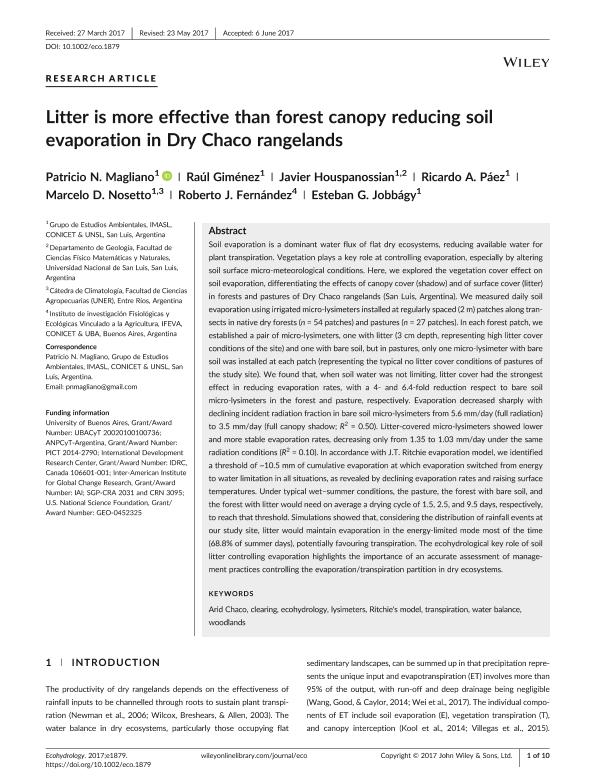Artículo
Litter is more effective than forest canopy reducing soil evaporation in Dry Chaco rangelands
Magliano, Patricio Nicolás ; Giménez, Raúl
; Giménez, Raúl ; Houspanossian, Javier
; Houspanossian, Javier ; Paez, Ricardo Andrés
; Paez, Ricardo Andrés ; Nosetto, Marcelo Daniel
; Nosetto, Marcelo Daniel ; Fernandez Alduncin, Roberto Javier
; Fernandez Alduncin, Roberto Javier ; Jobbagy Gampel, Esteban Gabriel
; Jobbagy Gampel, Esteban Gabriel
 ; Giménez, Raúl
; Giménez, Raúl ; Houspanossian, Javier
; Houspanossian, Javier ; Paez, Ricardo Andrés
; Paez, Ricardo Andrés ; Nosetto, Marcelo Daniel
; Nosetto, Marcelo Daniel ; Fernandez Alduncin, Roberto Javier
; Fernandez Alduncin, Roberto Javier ; Jobbagy Gampel, Esteban Gabriel
; Jobbagy Gampel, Esteban Gabriel
Fecha de publicación:
10/2017
Editorial:
John Wiley & Sons Inc
Revista:
Ecohydrology
ISSN:
1936-0584
Idioma:
Inglés
Tipo de recurso:
Artículo publicado
Clasificación temática:
Resumen
Soil evaporation is a dominant water flux of flat dry ecosystems, reducing available water for plant transpiration. Vegetation plays a key role at controlling evaporation, especially by altering soil surface micro-meteorological conditions. Here, we explored the vegetation cover effect on soil evaporation, differentiating the effects of canopy cover (shadow) and of surface cover (litter) in forests and pastures of Dry Chaco rangelands (San Luis, Argentina). We measured daily soil evaporation using irrigated micro-lysimeters installed at regularly spaced (2 m) patches along transects in native dry forests (n = 54 patches) and pastures (n = 27 patches). In each forest patch, we established a pair of micro-lysimeters, one with litter (3 cm depth, representing high litter cover conditions of the site) and one with bare soil, but in pastures, only one micro-lysimeter with bare soil was installed at each patch (representing the typical no litter cover conditions of pastures of the study site). We found that, when soil water was not limiting, litter cover had the strongest effect in reducing evaporation rates, with a 4- and 6.4-fold reduction respect to bare soil micro-lysimeters in the forest and pasture, respectively. Evaporation decreased sharply with declining incident radiation fraction in bare soil micro-lysimeters from 5.6 mm/day (full radiation) to 3.5 mm/day (full canopy shadow; R2 = 0.50). Litter-covered micro-lysimeters showed lower and more stable evaporation rates, decreasing only from 1.35 to 1.03 mm/day under the same radiation conditions (R2 = 0.10). In accordance with J.T. Ritchie evaporation model, we identified a threshold of ~10.5 mm of cumulative evaporation at which evaporation switched from energy to water limitation in all situations, as revealed by declining evaporation rates and raising surface temperatures. Under typical wet–summer conditions, the pasture, the forest with bare soil, and the forest with litter would need on average a drying cycle of 1.5, 2.5, and 9.5 days, respectively, to reach that threshold. Simulations showed that, considering the distribution of rainfall events at our study site, litter would maintain evaporation in the energy-limited mode most of the time (68.8% of summer days), potentially favouring transpiration. The ecohydrological key role of soil litter controlling evaporation highlights the importance of an accurate assessment of management practices controlling the evaporation/transpiration partition in dry ecosystems.
Archivos asociados
Licencia
Identificadores
Colecciones
Articulos(IMASL)
Articulos de INST. DE MATEMATICA APLICADA DE SAN LUIS
Articulos de INST. DE MATEMATICA APLICADA DE SAN LUIS
Citación
Magliano, Patricio Nicolás; Giménez, Raúl; Houspanossian, Javier; Paez, Ricardo Andrés; Nosetto, Marcelo Daniel; et al.; Litter is more effective than forest canopy reducing soil evaporation in Dry Chaco rangelands; John Wiley & Sons Inc; Ecohydrology; 10; 7; 10-2017; 1-10; e1879
Compartir
Altmétricas



